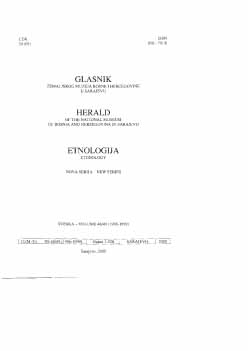Razvoj zanatstva i industrije u Sarajevu
Development of Handicraft and Industry in Sarajevo
Author(s): Mersida BakovljevSubject(s): Anthropology
Published by: Zemaljski muzej Bosne i Hercegovine
Summary/Abstract: Sarajevo is a city founded in a planned manner in the 15th century. Its establishment is related to coming of the Ottoman Turks to our region. The economic growth of Sarajevo started in the 16th century when the handicraft economy began its rapid growth. As a handicraft center, the city met all needs of domestic population. Serving as examplcs are thc appearance of traditional garb /all clothing items were the work of Sarajevo craftsmen, tailors ('"terzije") and tailors that sewed rural folk garbs ("abadžije")/, interior of houses/all wood-carving was done by domestic wood-earvers, the dishes were the work of domwstic coppersmiths ("kazandžije"), etc./the relationships within family / exclusive division of work to mail and female type/ and communication with the outside world / women used to live in separate houses never mixing with foreigners or going to the craft and trade center of the town -bazaar. Such patterns developing through centuries under the influence ul oriental culture, survived until the Austro-Hungarian occupation. After the Austro-Hungarian occupation Sarajevo became the main industrial center. Textile industry products substituted the traditional garb from the Ottoman period. The one-floored houses were substituted by two or three floored buildings. New household textile items were used, whereas the wood processing industry started producing chairs and tables which gradually replaced "sinijas". The food industry products changed the food culture and eating habits. Employing of girls effected changes in family structure and communication with the outside world. Girls started attending schools, and communication between men and women became more open providing them with opportunities to meet on promenades and date in an open manner. The socialist period brought about high rise residential buildings and uniformity reflected jn the motto of brotherhood and unity, in way of thinking, culture of dwelling, way of dressing and organization of work. However, after the destructive war 1992-1995, Sarajevo and its inhabitants experience still new transformations. Large number of refugees now lives in the city. Many factories are bought by foreign investors and consequently many employees lose their jobs. A great number of catering and trade objects are being opened and a new type of culture develops, in science known as mass culture. Varied types of garment are seen in the streets, from mini-skirts, tights and jeans to harem pants and long robes covering the whole body, and to classic al Western European suits characteristic for business people. The role of women becomes ever more prominent. Religious activity is on the increase and inter-confessionalism dominates in the overall picture. Public opinion is formed through media, whereas entertainment and free activities are reduced to idleness and sitting in cafes and other types of catering facilities, or visiting the surrounding picnic sites.
Journal: Glasnik Zemaljskog muzeja Bosne i Hercegovine u Sarajevu: Etnologija
- Issue Year: 1996
- Issue No: 48-49
- Page Range: 271-293
- Page Count: 23
- Language: Bosnian

